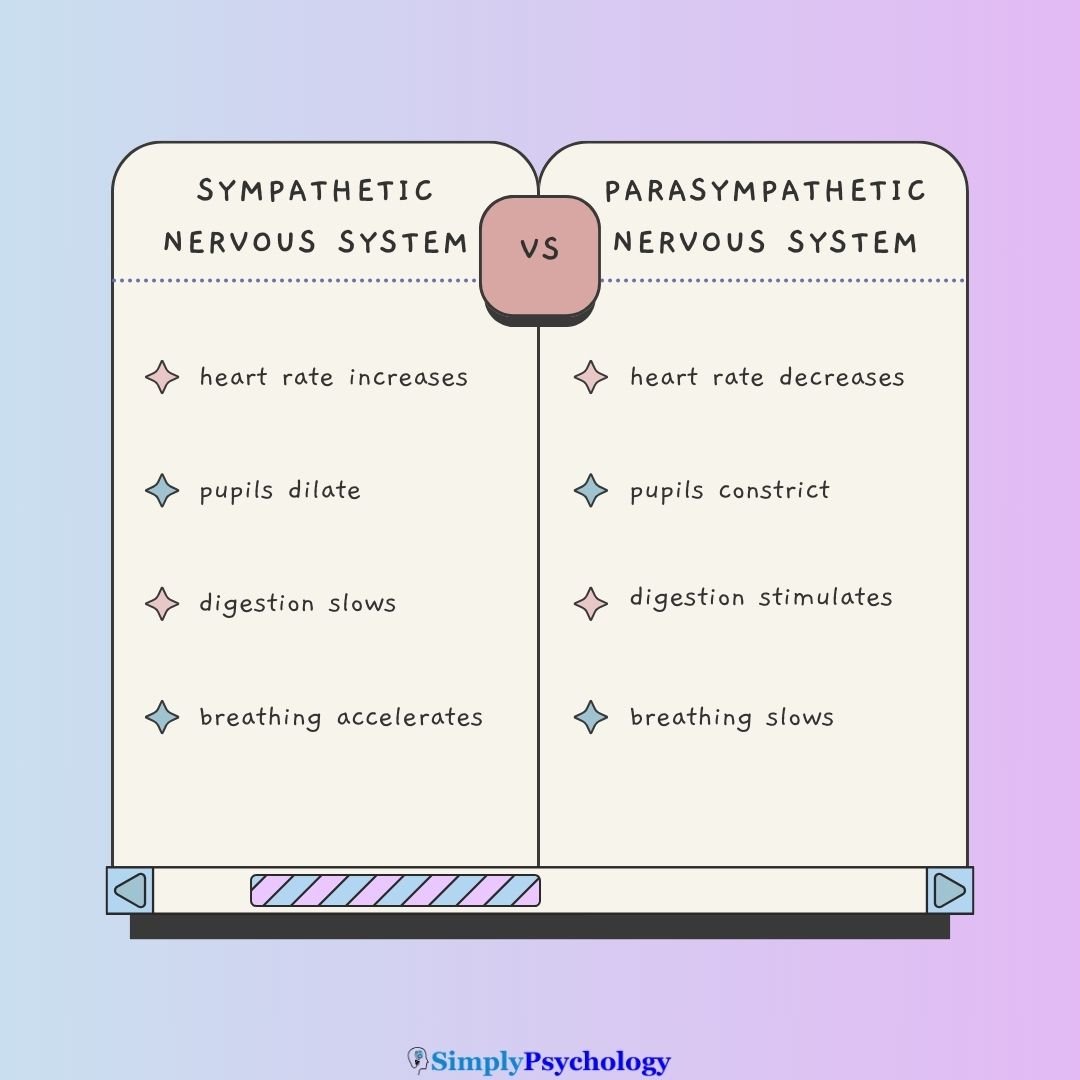The sympathetic nervous system (SNS) is one of two main divisions of the autonomic nervous system, which controls involuntary body processes like heart rate and digestion.
The SNS activates what is often termed the “fight or flight” response. When the body perceives a threat, the SNS stimulates bodily responses that serve to prepare the body for action in response to danger rapidly.

Key Takeaways
- The sympathetic nervous system helps you respond quickly to stress or danger.
- It triggers the fight-or-flight response, preparing the body to take action.
- The SNS works with neurotransmitters like norepinephrine and epinephrine to signal organs.
- Besides stress response, the SNS also helps regulate temperature and cardiovascular function.
- Chronic overactivation of the SNS can harm your health, but relaxation techniques can help restore balance.
Sympathetic vs. parasympathetic nervous system
The SNS works in opposition to the parasympathetic nervous system (PNS), which governs the “rest and digest” functions to conserve energy.
The parasympathetic branch stimulates digestion and the urinary system when relaxed, whereas the SNS slows them down as these processes are not required during heightened stress.
The neurons of the SNS also have shorter pathways than those of the parasympathetic nervous system.
This shorter distance allows for a quicker signal transmission; sometimes the responses happen before a person is consciously aware of them.
Together, the SNS and PNS work to maintain homeostasis in the body (the balance of internal physiological mechanisms).

Fight-or-Flight: Your Body’s Stress Response
The main role of the SNS is to trigger the “fight-or-flight” response. This reaction is your body’s way of preparing to face or escape a threat.
When activated, the SNS causes several automatic changes:
- Increases heart rate to pump more blood to muscles
- Dilates pupils to improve vision
- Slows digestion to conserve energy
- Stimulates sweat glands to cool the body
- Relaxes the bladder
- Heightens alertness for quicker reactions
Example: Imagine walking alone at night and hearing footsteps behind you. Your SNS immediately kicks in—you feel alert, your heart races, and your body gets ready to respond. Even non-life-threatening events like exams or public speaking can trigger this response.

Nerves of the SNS
The SNS uses a chain of neurons to send signals throughout the body. Here’s how it works:
- Preganglionic neurons start in the spinal cord (specifically in the thoracic and lumbar regions).
- They connect to ganglia, which are clusters of nerve cells outside the spinal cord.
- From there, postganglionic neurons carry the message to organs like the heart, lungs, and sweat glands.

Neurotransmitters in the SNS
The SNS uses neurotransmitters to communicate. Neurotransmitters are the chemical messengers that are transmitted through neurons.
These neurotransmitters are:
- Norepinephrine: also known as noradrenaline. It helps in activating the body and brain to act during the fight-or-flight response, aiding in alertness.
- Epinephrine: also known as adrenaline. Increases heart rate, dilates air passages and contracts blood vessels to help the body prepare for stressful or dangerous situations.
- Acetylcholine: plays a role in motivation, arousal, muscle function, and pupil dilation.
As a result, these neurotransmitters encourage the body’s organs involved in the SNS to respond to a threat.
Other SNS Roles
The SNS isn’t just about emergencies. It helps regulate other important body functions:
1. Body Temperature
- Stimulates sweat glands to cool the body
- Alters blood flow to the skin to conserve or release heat
- Triggers fat breakdown for warmth during cold conditions
2. Cardiovascular Support
- Helps adjust blood pressure and heart rate when you stand up
- Prepares the body for physical activity or waking up
- Prevents dizziness by maintaining blood flow to the brain
What Happens When the SNS Is Overactive or Underactive?
Sometimes, the SNS can become overactive or not work properly. This can lead to health issues:
Overactivation
- Constant stress can keep the SNS turned on
- Can raise blood pressure, increase heart disease risk, and damage arteries
- Linked to anxiety disorders like generalized anxiety disorder and panic disorder
Underactivation
- Can lead to poor judgment or slow physical responses
- May prevent the body from reacting to danger appropriately
How to Calm an Overactive SNS
If your body feels stuck in fight-or-flight mode, these strategies can help activate your parasympathetic system and promote relaxation:
- Deep breathing: Try square breathing (inhale for 4 counts, hold, exhale, hold)
- Mindfulness meditation: Focus on the present moment
- Progressive muscle relaxation: Tense and release muscle groups
- Regular exercise: Boosts long-term stress resilience
- Sleep: Aim for 7–9 hours a night
- Professional support: Seek therapy or medical help for chronic anxiety
Remember, everyone responds to stress differently, so it may take some experimentation to find the strategies that work best for you.
References
Alshak, M. N. (2019). Neuroanatomy, sympathetic nervous system.
Biology Dictionary. (October 4, 2019). Sympathetic Nervous System. https://biologydictionary.net/sympathetic-nervous-system/
Britannica, T. Editors of Encyclopaedia (2019, September 13). Sympathetic nervous system. Encyclopedia Britannica. https://www.britannica.com/science/sympathetic-nervous-system
Lumen. (n.d.). Functions of the Autonomic Nervous System. Retrieved May 5, 2021 from https://courses.lumenlearning.com/boundless-ap/chapter/functions-of-the-autonomic-nervous-system/



